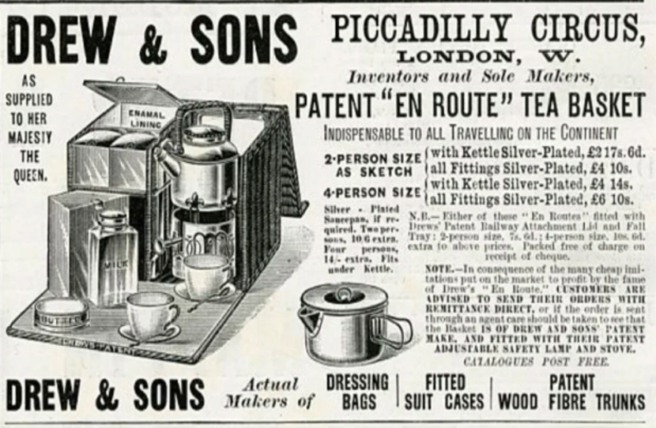This summer, the Frances Willard House Museum is highlighting stories of women’s mobility and travel. Many items on display at the Museum provide insight into the ways in which women crossed borders, transcended boundaries, and formed wide-ranging coalitions. The research and initial writing for this blogpost was conducted by Ali Schultz, Hana Ross, and Natalie Bierdz, undergraduate students in Professor Amy Tyson’s Spring 2023 Material Culture of U.S. Women’s History course at DePaul University.
In the 1830s, when alcohol consumption in the United States was at an all-time high, temperance advocates proudly adopted the name “Teetotaler” to promote total abstinence from the consumption of alcohol. While the word “Teetotaler” was not an explicit reference to tea the beverage, tea was a popular alternative drink for temperate Americans. By the 1890s, tea was such a favorite of Woman’s Christian Temperance Union (WCTU) President Frances Willard that she acquired a portable tea set to take with her on her extensive work-related travels.
The traveling tea set featured in the dining room of the Frances Willard House Museum is an authentic Drew & Sons piece. This company was active from the 1880s until the mid-1930s and worked out of a single location: 33 Piccadilly Circus, London. They produced a variety of items and were famous for their craftsmanship in silver, wicker, and leatherwork. One of their most popular items was the traveling tea set, which was initially marketed as “Patent ‘En Route’ Tea Basket” in several of their advertisements. The set was produced from 1896 to 1898 and sold for around £6.

The traveling tea set originally included two metal cups, a tea kettle, a water pot, a small stove, several compartments for tea, and a wicker basket with a leather handle for transport. In Willard’s set, some of the original items are missing, including two metal cups and small accessories. The tea set allowed for easy, independent preparation of tea on a train. Willard likely received this tea set as a gift from her good friend, Lady Isabel Somerset, the president of the British Women’s Temperance Association, rendering it a symbol of transatlantic women’s reform connections.

Tea enjoyed a prominent place in the history of temperance advocacy. In 1785 Evangelical poet William Cowper described tea as “the cup that cheers but does not inebriate.” Guests at mid-nineteenth-century temperance tea parties enjoyed cakes, pastries, fruits, and lots of tea while listening to prominent movement leaders discuss the problem of alcohol. Tea-serving women became symbols of a healthy family and community. Temperance teas facilitated reform organizing by, in the words of cultural historian Erika Rappaport, “encouraging pleasurable cross-class and cross-gender interactions.” Attendees hoped that “the values inculcated at the tea tables would radiate to the home and workplace.”
Nineteenth-century separate spheres ideology, which was rooted in concepts of innate gender difference, restricted women’s mobility and social freedom. While men regularly found sociability and refreshment in saloons, restaurants, and gentleman’s clubs, many public dining places barred women or adopted gender-segregated seating. By the end of the century, temperance spas began offering tea, coffee, and non-alcoholic cocktails in the name of promoting patrons’ physical and moral health. Although designed to look like a men’s saloon, temperance spas made a point of serving men and women together, thereby offering women a rare chance to eat, drink, and socialize outside the home and while on the road.

When women transposed the tea ritual to temperance organizing, “taking tea” became more than a means of fostering female companionship in domestic settings. By conversing over tea, women learned to deliberate political issues, organize reform networks, and claim ownership over public space.
Works Consulted
Cowper, William. The Task. London: Cassell & Company, 1899. (Electronically pub. Dorset: Les Bowler, 2015.)
“Drew and Sons 1887 – 1935.” Science Museum Group Online. Accessed May 7, 2023. https://collection.sciencemuseumgroup.org.uk/people/cp3530/drew-and-sons.
Poole, Judith Ann. “Taking Tea in the Parlour: Middle-Class Formation and Gender Construction in Nova Scotia and New Brunswick, 1760-1850.” Masters abstracts international 46, no. 6 (2008).
Rappaport, Erika. “Sacred and Useful Pleasures: The Temperance Tea Party and the Creation of a Sober Consumer Culture in Early Industrial Britain.” Journal of British Studies 52, no. 4 (2013): 990–1016. http://www.jstor.org/stable/24700889.
Smith, Andrew F. “The Temperance Beverage.” In Drinking History, 155–166. New York Chichester, West Sussex: Columbia University Press, 2015.
